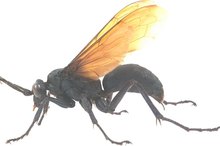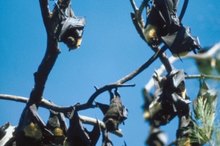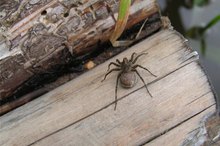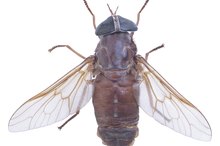Symptoms of a Black House Spider Bite
Although the black house spider can look intimidating because of its dark coloring, thick legs, and generally large size -- females average just under 1 inch -- they usually will not bite humans unless provoked or unless they feel as if they are in danger 1. While the bite of the black house spider is not usually lethal, it is venomous and can cause harmful and uncomfortable effects to the bitten victim 1. Unlike what its name suggests, black house spiders can be found inside homes and outside 1.
Common Short-Term Side Effects
Black house spider bites, while infrequent, usually cause an extensive amount of pain at the bite site 1. This pain is more likely to last more than 24 hours, due to the venomous nature of the black house spider 1. Local swelling and redness of the skin are also usually seen soon after a bite, and can last anywhere from a few hours to a couple of days, depending on the severity of the bite and the amount of venom injected. To identify the bite as a spider bite, look for small puncture wounds where there is pain and swelling.
Possible Short-Term Effects
How to Tell If You Have a Wasp Bite or Sting
Learn More
Some victims of black house spider bites may experience nausea, vomiting, and abdominal pain as a result of the spider venom 1. Lethargy and mild headaches soon after the bite may also occur.
Extraordinary Side Effects
While rare, there have been documented examples of dangerous and severe reactions to black house spider bites, especially if you are bitten more than once 1. Skin lesions, or arachnogenic necrosis, may appear soon after the bites, causing local blistering, ulcers and necrosis.
Treatment for Black House Spider Bites
Signs of a Bat Bite
Learn More
Although black house spider bites are not nearly as dangerous as other spider bites, they can still cause severe pain and some injury, especially to the local area 1. To reduce swelling and pain, thoroughly wash and ice the bite as soon as you notice it, and consider taking a pain-relieving medicine. If the pain and the swelling persist for an extended period of time, consult your doctor for further medical advice and treatment, especially if you begin to notice symptoms other than mere pain and swelling.
Related Articles
References
- Orkin: Black House Spider
- Australian Venom Research Unit: Other Spiders
- Cedars Sinai Medical Center. Brown Recluse and Black Widow Spider Bites in Children.
- Sotelo-cruz N, Gómez-rivera N. [Neurotoxic manifestations of black widow spider envenomation in paediatric patients]. Neurologia. 2016;31(4):215-22. doi:10.1016/j.nrl.2015.05.007
- Williams M, Nappe TM. Black Widow Spider Toxicity. StatPearls Publishing. Updated March 8, 2019.
- Stoecker WV, Vetter RS, Dyer JA. NOT RECLUSE-A Mnemonic Device to Avoid False Diagnoses of Brown Recluse Spider Bites. JAMA Dermatol. 2017;153(5):377-378. doi:10.1001/jamadermatol.2016.5665
- Vetter RS. The distribution of brown recluse spiders in the southeastern quadrant of the United States in relation to loxoscelism diagnoses. South Med J. 2009;102(5):518-22. doi:10.1097/SMJ.0b013e3181a0abb3
- Illinois Department of Public Health. Brown Recluse and Black Widow Spiders.
- Rahmani F, Banan Khojasteh SM, et al. Poisonous Spiders: Bites, Symptoms, and Treatment; an Educational Review. Emerg (Tehran). 2014;2(2):54-8.
- Gaver-wainwright MM, Zack RS, Foradori MJ, Lavine LC. Misdiagnosis of spider bites: bacterial associates, mechanical pathogen transfer, and hemolytic potential of venom from the hobo spider, Tegenaria agrestis (Araneae: Agelenidae). J Med Entomol. 2011;48(2):382-8. doi:10.1603/ME09224
- Livshits Z, Bernstein B, Sorkin LN, Smith SW, Hoffman RS. Wolf spider envenomation. Wilderness Environ Med. 2012;23(1):49-50. doi:10.1016/j.wem.2011.11.010
- Meires J, Louden B. Bite of the Brown Recluse Spider. Clinical Review. 2010(12):14-17.
- Pagac BB, Reiland RW, Bolesh DT, Swanson DL. Skin lesions in barracks: consider community-acquired methicillin-resistant Staphylococcus aureus infection instead of spider bites. Mil Med. 2006;171(9):830-2. doi:10.7205/milmed.171.9.830
- Mikals K, Beakes D, Banks TA. Stinging the Conscience: A Case of Severe Hymenoptera Anaphylaxis and the Need for Provider Awareness. Mil Med. 2016;181(10):e1400-e1403. doi:10.7205/MILMED-D-15-00536
- Gaver-Wainwright MM, Zack RS, Foradori MJ, Lavine LC. Misdiagnosis of spider bites: bacterial associates, mechanical pathogen transfer, and hemolytic potential of venom from the hobo spider, Tegenaria agrestis (Araneae: Agelenidae). J Med Entomol. 2011 Mar;48(2):382-8.
- Isbister GK, Framenau VW. Australian wolf spider bites (Lycosidae): clinical effects and influence of species on bite circumstances. J Toxicol Clin Toxicol. 2004;42(2):153-61.
- Livshits, Z., Bernstein, B., Sorkin, L., Smith, S., & Hoffman, R. (2012). Wolf Spider Envenomation. Wilderness & Environmental Medicine, 23(1), 49-50. doi:10.1016/j.wem.2011.11.010
- Pagac BB, Reiland RW, Bolesh DT, Swanson DL. Skin lesions in barracks: consider community-acquired methicillin-resistant Staphylococcus aureus infection instead of spider bites. Mil Med. 2006 Sep;171(9):830-2.
- Payne, K., Schilli, K., Meier, K., Rader, R., Dyer, J., & Mold, J. et al. (2014). Extreme Pain From Brown Recluse Spider Bites. JAMA Dermatology, 150(11), 1205. doi:10.1001/jamadermatol.2014.605
- Robinson, J., Kennedy, V., Doss, Y., Bastarache, L., Denny, J., & Warner, J. (2017). Defining the complex phenotype of severe systemic loxoscelism using a large electronic health record cohort. PLOS ONE, 12(4), e0174941. doi:10.1371/journal.pone.0174941
- Stoecker, W., Vetter, R., & Dyer, J. (2017). NOT RECLUSE—A Mnemonic Device to Avoid False Diagnoses of Brown Recluse Spider Bites. JAMA Dermatology. doi:10.1001/jamadermatol.2016.5665
Writer Bio
Natalie O'Hara has been writing and publishing online since 2009. She has a background in articles regarding current events and pop-culture trivia, contributing articles to various websites. O'Hara is pursuing a Bachelor of Arts in English literature.








